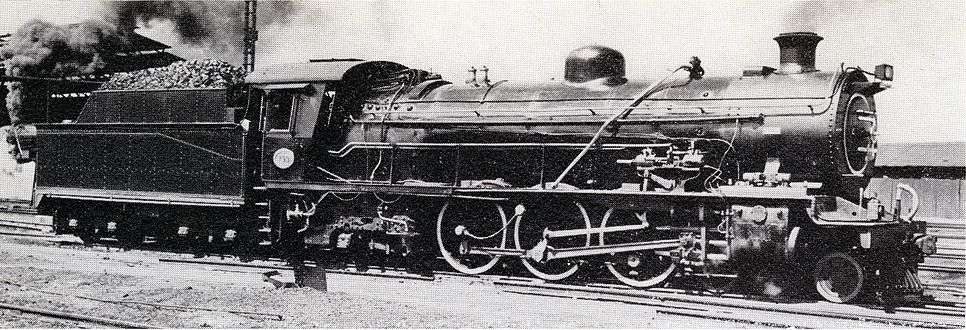South African Class 16 4-6-2
|
Class 16 no. 800, Braamfontein, c. 1930 | |||||||||||||||||||||||||||||||||||||||||||||||||||||||||||||||||||||||||||||||||||||||||||||||||||||||||||||||
| |||||||||||||||||||||||||||||||||||||||||||||||||||||||||||||||||||||||||||||||||||||||||||||||||||||||||||||||
| |||||||||||||||||||||||||||||||||||||||||||||||||||||||||||||||||||||||||||||||||||||||||||||||||||||||||||||||
| |||||||||||||||||||||||||||||||||||||||||||||||||||||||||||||||||||||||||||||||||||||||||||||||||||||||||||||||
| |||||||||||||||||||||||||||||||||||||||||||||||||||||||||||||||||||||||||||||||||||||||||||||||||||||||||||||||
| The 2nd coupled axle had flangeless wheels | |||||||||||||||||||||||||||||||||||||||||||||||||||||||||||||||||||||||||||||||||||||||||||||||||||||||||||||||
The South African Railways Class 16 4-6-2 of 1914 was a steam locomotive.
In 1914, the South African Railways placed twelve Class 16 steam locomotives with a 4-6-2 Pacific type wheel arrangement in passenger train service.[1][2][3]
Manufacturer
The Class 16 4-6-2 Pacific type passenger locomotive was designed by D.A. Hendrie, Chief Mechanical Engineer (CME) of the South African Railways (SAR) from 1910 to 1922, and was built by the North British Locomotive Company in Glasgow, Scotland, who delivered twelve locomotives in 1914, numbered in the range from 790 to 801.[1][2][3][4]
Characteristics

The design of the Class 16 closely followed that of Hendrie's Class 15 4-8-2 Mountain type, which was introduced at the same time from the same builders, and many parts were made interchangeable.[1][3]
The cylinders were arranged outside the plate frames, with the piston valves above the cylinders and actuated by Walschaerts valve gear. The boilers were equipped with superheaters and had Belpaire fireboxes. The engines were delivered new with Type MP1 tenders with a 10 long tons (10.2 tonnes) coal capacity and a 4,250 imperial gallons (19,300 litres) water capacity.[1][2][3][5][6]
Power comparison
When it was built in 1914, the Class 16 was considered to be a very large and powerful express locomotive, even when compared to British locomotives which were built to run on 4 feet 8 1⁄2 inches (1,435 millimetres) broad gauge. As built, with 60 inches (1,524 millimetres) diameter coupled wheels, the ratio of wheel diameter to rail gauge was the same as that of a broad gauge locomotive with 81 inches (2,057 millimetres) diameter coupled wheels. Their tractive effort of 29,890 pounds-force (133.0 kilonewtons) at 75% boiler pressure exceeded the 27,800 pounds-force (124 kilonewtons) at 85% boiler pressure of Churchward's The Great Bear Pacific on the Great Western Railway and equalled, also at 85% boiler pressure, that of Gresley's later Great Northern Pacifics. This made the Class 16 the most powerful express passenger locomotive design yet to have been built in Great Britain at the time.[7]
Watson Standard boilers
During the 1930s, many serving locomotives were reboilered with a standard boiler type, designed by A.G. Watson, CME of the SAR from 1929 to 1936, as part of his standardisation policy. Such Watson Standard reboilered locomotives were reclassified by adding an "R" suffix to their classification.[3][5][6]
Eventually all twelve Class 16 locomotives were reboilered with Watson Standard no. 2B boilers and reclassified to Class 16R. Early conversions were equipped with copper and later conversions with steel fireboxes. In the process, they were also equipped with Watson cabs, with their distinctive slanted fronts, compared to the conventional vertical fronts of their original cabs.[3][5][6]
Their original Belpaire boilers were fitted with Ramsbottom safety valves, while the Watson Standard boiler was fitted with Pop safety valves. An obvious visual difference between an original and a Watson Standard reboilered locomotive is usually a rectangular regulator cover, just to the rear of the chimney on the reboilered locomotive. In the case of the Class 16 and Class 16R locomotives, two even more obvious differences are the Watson cab and the absence of the Belpaire firebox hump between the cab and boiler on the reboilered locomotives.[3][5][6]
Service
The Class 16 was intended for fast passenger trains in the Transvaal, Orange Free State and the upper sections of Natal, where the gradients were not as severe. They were placed in suburban passenger service, working between Pretoria and Johannesburg, and in mainline service on the section from Johannesburg to Volksrust on the line to Natal. In later years, after being withdrawn from mainline passenger service, many of these locomotives remained employed in suburban passenger working and shunting service.[1][2][3][7]
Illustration
The main picture shows Class 16 no. 800 at Braamfontein c. 1930, as built with a Belpaire firebox and Type MP1 tender, on interurban service with a destination board for Pretoria below its headlight.
_Playing_Cards.jpg) Class 16 no. 790, as built, on a SAR Museum playing card
Class 16 no. 790, as built, on a SAR Museum playing card Class 16R no. 793 with a modified Type MP1 tender
Class 16R no. 793 with a modified Type MP1 tender
References
- 1 2 3 4 5 Holland, D.F. (1972). Steam Locomotives of the South African Railways, Volume 2: 1910-1955 (1st ed.). Newton Abbott, Devon: David & Charles. p. 27. ISBN 978-0-7153-5427-8.
- 1 2 3 4 Espitalier, T.J.; Day, W.A.J. (1945). The Locomotive in South Africa - A Brief History of Railway Development. Chapter VII - South African Railways (Continued). South African Railways and Harbours Magazine, August 1945. p. 594.
- 1 2 3 4 5 6 7 8 Paxton, Leith; Bourne, David (1985). Locomotives of the South African Railways (1st ed.). Cape Town: Struik. pp. 10–11 & 64. ISBN 0869772112.
- ↑ North British Locomotive Company works list, compiled by Austrian locomotive historian Bernhard Schmeiser
- 1 2 3 4 South African Railways & Harbours/Suid Afrikaanse Spoorweë en Hawens (15 Aug 1941). Locomotive Diagram Book/Lokomotiefdiagramboek, 3'6" Gauge/Spoorwydte. SAR/SAS Mechanical Department/Werktuigkundige Dept. Drawing Office/Tekenkantoor, Pretoria. p. 43.
- 1 2 3 4 South African Railways & Harbours/Suid Afrikaanse Spoorweë en Hawens (15 Aug 1941). Locomotive Diagram Book/Lokomotiefdiagramboek, 2'0" & 3'6" Gauge/Spoorwydte, Steam Locomotives/Stoomlokomotiewe. SAR/SAS Mechanical Department/Werktuigkundige Dept. Drawing Office/Tekenkantoor, Pretoria. pp. 6a-7a, 41, 43.
- 1 2 Durrant, A E (1989). Twilight of South African Steam (1st ed.). Newton Abbott, London: David & Charles. pp. 92–93. ISBN 0715386387.
| Wikimedia Commons has media related to South African Class 16 (4-6-2). |
.jpg)